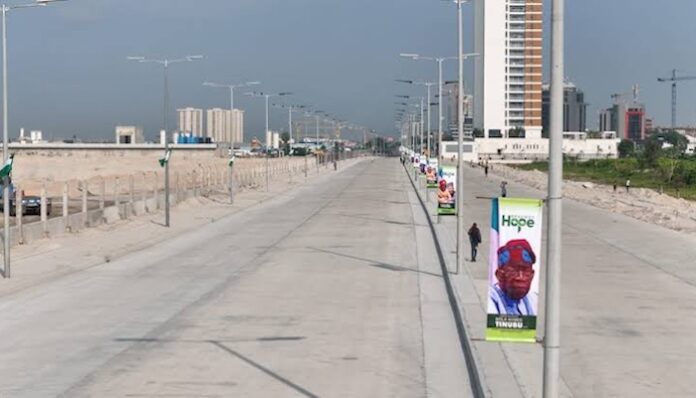The Federal Government has announced that the first completed portion of Section One of the Lagos–Calabar Coastal Highway will be opened to motorists between December 12 and 17, 2025, marking a major milestone in one of Nigeria’s most ambitious road projects. The full commissioning of Section One is expected to take place in April 2026, according to the Minister of Works, David Umahi.
Umahi made the announcement on Sunday during an inspection tour of the highway, where he assessed ongoing works on a 47.37-kilometre stretch of the project. He expressed satisfaction with the level of progress, noting that only about two kilometres of Section One remain to be fully completed.
The Lagos–Calabar Coastal Highway is designed as a 700-kilometre dual carriageway running from Victoria Island, Lagos, through the coastal states of the South West and South South, before terminating in Calabar, Cross River State. When completed, the road is expected to connect major economic zones, support tourism, open up coastal communities and ease movement between key port cities.
The project is also part of the Federal Government’s broader plan to modernise road infrastructure and boost economic growth through improved transportation networks.
Speaking with journalists during the tour, Umahi said the construction team had deliberately slowed work on some areas of Section One to allow proper subsoil settlement. He explained that this was an important engineering step aimed at ensuring the road’s long-term durability.
According to him, “The slowdown is deliberate. We want the soil to settle properly. It is an engineering requirement meant to protect the lifespan and structural integrity of the highway.”
He highlighted that the government is prioritizing quality over speed, stressing that the aim is to deliver a coastal highway that can last many decades without major structural failures.
The minister commended the contractor, Hitech Construction Company, for what he described as an “uncommon commitment” to the project. He said the company’s dedication has gone beyond normal financial motivation, noting that its technical expertise and pace of work have exceeded expectations.
Umahi also revealed that the foreign loan component for the project was oversubscribed by $100 million, an indication, he said, of strong investor confidence in the project’s economic importance as well as the ministry’s transparent handling of funds.
Hitech Managing Director, Danny Aboud, who also spoke during the inspection, said work was progressing smoothly across all critical segments. He noted that sand filling is advancing steadily across swamp zones, while about 34 to 35 kilometres of concrete reinforced pavement had already been completed.
Concrete roads, unlike asphalt, have longer life spans and require less frequent maintenance. This design choice, the government says, is aimed at reducing long-term repair costs and improving road quality.
The inspection covered more than just the Lagos city area. Umahi also toured several other components connected to the coastal highway, including:
A 25-kilometre dual carriageway under construction between Eleko (near Dangote Cement) and Ijebu-Ode in Ogun State.
An expansive flyover at Chainage 47.474, intended to connect Sections One and Two of the highway.
According to him, the flyover is already 80 percent complete in piling works and is expected to be delivered in the first quarter of 2026. When completed, the interchange will significantly ease movement into and out of the Lekki industrial corridor, linking the highway to the Dangote Refinery and deep-sea port.
The Lagos–Calabar Coastal Highway is expected to boost commerce, transportation and coastal tourism, while also opening up economic opportunities in areas that previously lacked major road networks. The government has said the highway will support millions of jobs directly and indirectly through construction, logistics, tourism and business expansion.
For Lagos, the project will help decongest traditional routes such as the Lekki-Epe expressway. For the South South region, the highway will improve regional connectivity and strengthen access to ports.
During the inspection, Umahi also announced the rollout of the President Bola Tinubu Engineering Mentorship Programme, scheduled to begin in January. The programme is aimed at training the next generation of Nigerian engineers and reducing the country’s reliance on foreign technical expertise.
The initiative will recruit civil engineers, electrical engineers, designers and technicians nationwide. Participants will receive hands-on training while working on major federal projects such as the coastal highway and the Sokoto–Badagry road.
After completing their training, participants will receive start-up support, including equipment, which the minister said will help strengthen Nigeria’s indigenous engineering capacity.
Umahi assured Nigerians that the ministry is committed to transparency and accountability in managing the project. He added that every stage of the highway construction follows global engineering standards, especially in soil stabilization, drainage, concrete strength and long-term durability.
The minister also noted that the gradual opening of completed sections will help motorists and businesses experience the benefits of the project even before full completion.
The Lagos–Calabar Coastal Highway has been one of the most discussed federal projects in recent times. It has drawn praise for its ambition and potential economic impact, but has also faced scrutiny—particularly around compensation for affected communities, concerns about environmental impact and questions about funding structure.
However, many Nigerians say they are encouraged by the pace of work and the government’s decision to open the first completed portion by December.
Transport analysts say early access to Section One will help ease congestion along the Lekki–Epe corridor and allow residents, transport companies and businesses to become familiar with the new route.
As construction continues, the Lagos–Calabar Coastal Highway is shaping up to become one of the most transformative infrastructure projects ever undertaken in Nigeria. Beyond improving road travel, the project is expected to stimulate industries, expand access to coastal communities and promote long-term economic growth.

